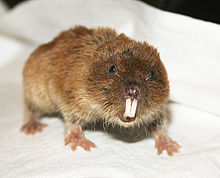- Northern Mole Vole
-
Northern Mole Vole 
Conservation status Scientific classification Kingdom: Animalia Phylum: Chordata Class: Mammalia Order: Rodentia Family: Cricetidae Genus: Ellobius Species: E. talpinus Binomial name Ellobius talpinus
(Pallas, 1770)Synonyms E. ciscaucasicus Sviridenko, 1936
E. murinus Pallas, 1770
E. rufescens Eversmann, 1850
E. tanaiticus Zubko, 1940
E. transcaspiae Thomas, 1912[2]
Mus talpinus, Pallas
Spalax murinus, Pallas
Georychus rufescens, Eversmann[3]The northern mole vole (Ellobius talpinus) is a species of rodent in the family Cricetidae. It is distributed over large parts of Eastern Europe and Asia.
Contents
Distribution
This vole is found in Kazakhstan, Turkmenistan, Kyrgyzstan, Uzbekistan and Ukraine, the southern parts of Russia, western Siberia, northern Afghanistan, Mongolia and northern China.[4]
Morphology
Northern mole voles are small mammals about 130 millimetres long with a short tail, weighing up to seventy grams. The females are slightly larger than the males. The body is wedge-shaped, the head flat, the neck short and the musculature of the fore-limbs strongly developed. They have short dense brownish fur somewhat paler on the underparts. The feet are naked and pink. They are adapted to life underground, digging their burrows with the help of their large incisors.[4]
Biology
The northern mole vole is diurnal and active all day. There is a decrease in activity during periods of drought and in the winter but there is no true hibernation period.[4] A study undertaken in 2001 found that the vole's adaptation to the extremes of the continental climate is based on distinct seasonal variations of thermoregulation.[5] The gestation period lasts three weeks and there may be three or four litters a year, with two to four young voles in each. These grow rapidly and are sexually mature at the age of six weeks.[4]
Ecology
This vole is a colonial species, living in groups of about ten individuals, typically a family group of one pair of adults and young animals from one or two litters. The burrows are complex, the entrances are usually sealed by soil and the nesting chambers and fodder chambers are usually about four metres beneath the surface.[6] The animals feed on roots, bulbs, tubers and the juicy rhizomes of plants, and in the summer and autumn they store small stocks of food.[4] They seldom emerge onto the surface except to distribute soil excavated from the burrow or to move to new territories, at which times they can cover distances of up to 800 metres.[6] The population size varies being limited by infectious diseases, parasites, severe winters with deep-frozen ground, spring flooding of burrows by melt water and predatory birds and mammals.[4]
References
- ^ Tsytsulina, K. & Zagorodnyuk, I. (2008). Ellobius talpinus. In: IUCN 2008. IUCN Red List of Threatened Species. Downloaded on 24 May 2009. Database entry includes a brief justification of why this species is of least concern.
- ^ Mammal Species of the World
- ^ http://www.bucknell.edu/msw3/browse.asp?id=13000206
- ^ a b c d e f AgroAtlas
- ^ Seasonal changes of thermoregulation in the mole vole Ellobius talpinus
- ^ a b IUCN Red Book
- Musser, G. G. and M. D. Carleton. 2005. Superfamily Muroidea. pp. 894–1531 in Mammal Species of the World a Taxonomic and Geographic Reference. D. E. Wilson and D. M. Reeder eds. Johns Hopkins University Press, Baltimore.
Categories:- IUCN Red List least concern species
- Voles and lemmings
- Mammals of Kazakhstan
- Mammals of Turkmenistan
- Mammals of Ukraine
Wikimedia Foundation. 2010.

